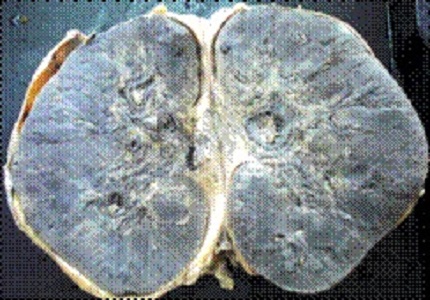An analysis of adult non-neoplastic nephrectomies at a tertiary care centre in Mumbai
Abstract
Introduction: Nephrectomies are an integral part of urological practice and a wide range of renal diseases are seen on histopathological examination of non-neoplastic nephrectomy specimens.
Objective: The objective of this study was to assess the incidence, clinical presentation and the histological spectrum of various non-neoplastic renal diseases detected in nephrectomy specimens at our institute and to compare our observations with the conventional patterns seen.
Material and Methods: This is a retrospective 6 year study of adult non-neoplastic nephrectomies (ANNN) conducted in a tertiary care centre in Mumbai and includes 359 cases from January 2009 to December 2015. The paraffin blocks and slides were retrieved from our archives and analysed along with clinical features, radiological findings.
Results: 359 ANNN specimens received over a 6 year period were studied. Most of the patients were in the sixth decade with a slight female preponderance. Flank pain was the commonest presenting symptom seen in 79.94% of cases. The most frequent surgical indication for ANNN was obstructive uropathy (47.08%) which includes calculus disease and PUJ obstruction followed by non-functioning kidney (42.06%). On histopathological examination, the most common gross pathology was acalculus hydronephrosis (40.67%) and the most frequent histopathological diagnosis was chronic pyelonephritis seen in 79.38% cases. Calculus obstructive uropathy amounted to 39.27% cases and acalculus obstructive uropathy amounted to 25.07% cases of chronic pyelonephritis.
Conclusion: The most frequent surgical indication was obstructive uropathy and the most common histopathological diagnosis was chronic pyelonephritis. Calculus and acalculus obstructive uropathy amounted to almost 65% of the cases of chronic pyelonephritis.
Downloads
References
Aiman A, Singh K, Yasir M. Histopathological spectrum of lesions in nephrectomy specimens: A five year experience in a tertiary care hospital. J Sci Soc. 2013;40(3):148-54. DOI: http://www.jscisociety.com/text.asp?2013/40/3/148/120058.
Divyashree B N, Kusuma V, Madhusudhan H R, Hanumantha R B. Pathological Spectrum of Non-Neoplastic Diseases in the Nephrectomy Specimens. J Evidence Based Med and Hlthcare 2014;15(1);1909-1920. https://www.jebmh.com/data_pdf/3_Kusuma%20Venkatesh.pdf.
Zaki M R, Ghazanfar A, Asif K. Nephrectomy for non-traumatic benign renal diseases: Its indications and outcomes in a developing country. Pak J Med Health Sci. 2012; 6(1):216-9.
Zisman A. Laparoscopic nephroureterectomy: is it always as good as open nephroureterectomy? Eur Urol. 2010 Nov;58(5):652-3; discussion 653-4. doi: https://doi.org/10.1016/j.eururo.2010.08.039. Epub 2010 Sep 15.
Al-Khalil N, Panchev P, Kumanov Kh. History of nephrectomy. Khirurgiia(Sofiia). 1999;55(5):38-9.
Wszolek MF, Kenney PA, Libertino JA. Nonclamping partial nephrectomy: towards improved nephron sparing. Nat Rev Urol. 2011 Aug 2;8(9):523-7. doi: https://doi.org/10.1038/nrurol.2011.103.
Schissel BL, Johnson BK. Renal stones: evolving epidemiology and management. Pediatr Emerg Care. 2011; 27(7):676-81. DOI: https://doi.org/10.1097/PEC.0b013e3182228f10.
Sujatha S, Kowsalya R, Mythri K M. Benign nephrectomies and its variables along with vascular changes in the renal artery: A study from tertiary care centre from south India. J of Nephrol and Urol Res. 2014; 2: 14-18. DOI: http://dx.doi.org/10.12970/2310-984X.2014.02.01.3.
Sreedhar VV, Paul MC, Sirisha O, Shivaram P, Sudhir NV, Chandrakumar S. Pathological study of elective nephrectomies for a two year period. Int J Res Med Sc.i 2015;3:1496-500. DOI: http://dx.doi.org/10.18203/2320-6012.ijrms20150174.
Li L, Parwani AV. Xanthogranulomatous pyelonephritis. Arch Pathol Lab Med. 2011 May;135(5):671-4. doi: https://doi.org/10.1043/2009-0769-RSR.1.
Elangovan S, Bhuvaneswari V, Kannan R R, Dorairajan L N. Interesting case of tuberculosis in a horseshoe kidney mimicking malignant tumor. Indian J Radiol Imaging 2002;12 (4):513-4. http://www.ijri.org/text.asp?2002/12/4/513/28527.
Chikkannaiah P, Kangle R, Bali A, Honawad MN. Polycystic horseshoe kidney. Med J Armed Forces India. 2015 Jul;71(Suppl 1):S181-3. doi: https://doi.org/10.1016/j.mjafi.2013.12.002. Epub 2014 Mar 12.
Batista Peres LA, Leonel Ferreira JR, Alvares Delfino VD. Polycystic horseshoekidney. Nephrol Dial Transplant. 2007 Feb;22(2):652-3 DOI: https://doi.org/10.1093/ndt/gfl615.
Halvorson CR, Bremmer MS, Jacobs SC. Polycystic kidney disease: inheritance, pathophysiology, prognosis, and treatment. Int J Nephrol Renovasc Dis. 2010;3:69-83. Epub 2010 Jun 24.



 OAI - Open Archives Initiative
OAI - Open Archives Initiative


